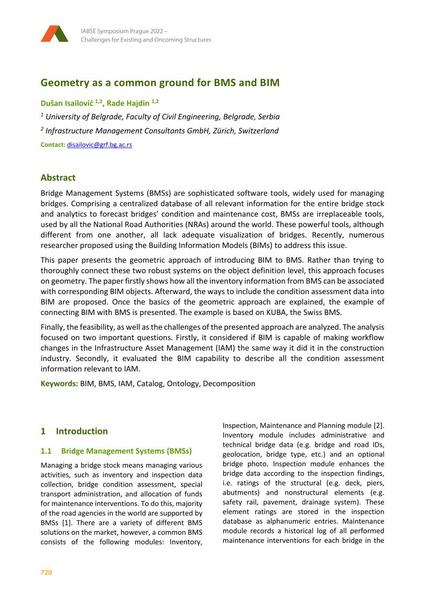Geometry as a common ground for BMS and BIM

|
|
|||||||||||
Bibliographic Details
| Author(s): |
Dušan Isailović
(University of Belgrade, Faculty of Civil Engineering, Belgrade, Serbia; Infrastructure Management Consultants GmbH, Zürich, Switzerland)
Rade Hajdin |
||||
|---|---|---|---|---|---|
| Medium: | conference paper | ||||
| Language(s): | English | ||||
| Conference: | IABSE Symposium: Challenges for Existing and Oncoming Structures, Prague, Czech Republic, 25-27 May 2022 | ||||
| Published in: | IABSE Symposium Prague 2022 | ||||
|
|||||
| Page(s): | 720-726 | ||||
| Total no. of pages: | 7 | ||||
| DOI: | 10.2749/prague.2022.0720 | ||||
| Abstract: |
Bridge Management Systems (BMSs) are sophisticated software tools, widely used for managing bridges. Comprising a centralized database of all relevant information for the entire bridge stock and analytics to forecast bridges’ condition and maintenance cost, BMSs are irreplaceable tools, used by all the National Road Authorities (NRAs) around the world. These powerful tools, although different from one another, all lack adequate visualization of bridges. Recently, numerous researcher proposed using the Building Information Models (BIMs) to address this issue. This paper presents the geometric approach of introducing BIM to BMS. Rather than trying to thoroughly connect these two robust systems on the object definition level, this approach focuses on geometry. The paper firstly shows how all the inventory information from BMS can be associated with corresponding BIM objects. Afterward, the ways to include the condition assessment data into BIM are proposed. Once the basics of the geometric approach are explained, the example of connecting BIM with BMS is presented. The example is based on KUBA, the Swiss BMS. Finally, the feasibility, as well as the challenges of the presented approach are analyzed. The analysis focused on two important questions. Firstly, it considered if BIM is capable of making workflow changes in the Infrastructure Asset Management (IAM) the same way it did it in the construction industry. Secondly, it evaluated the BIM capability to describe all the condition assessment information relevant to IAM. |
||||
| Keywords: |
BIM BMS ontology IAM Catalog Decomposition
|
||||
| Copyright: | © 2022 International Association for Bridge and Structural Engineering (IABSE) | ||||
| License: | This creative work is copyrighted material and may not be used without explicit approval by the author and/or copyright owner. |
||||
